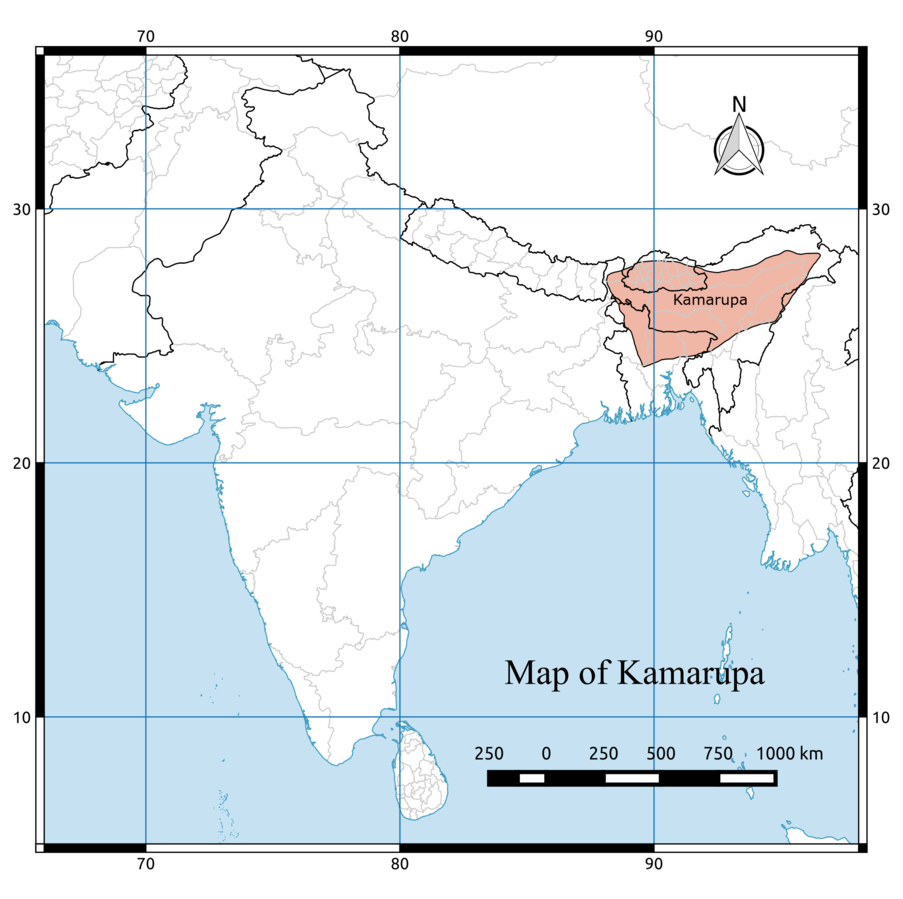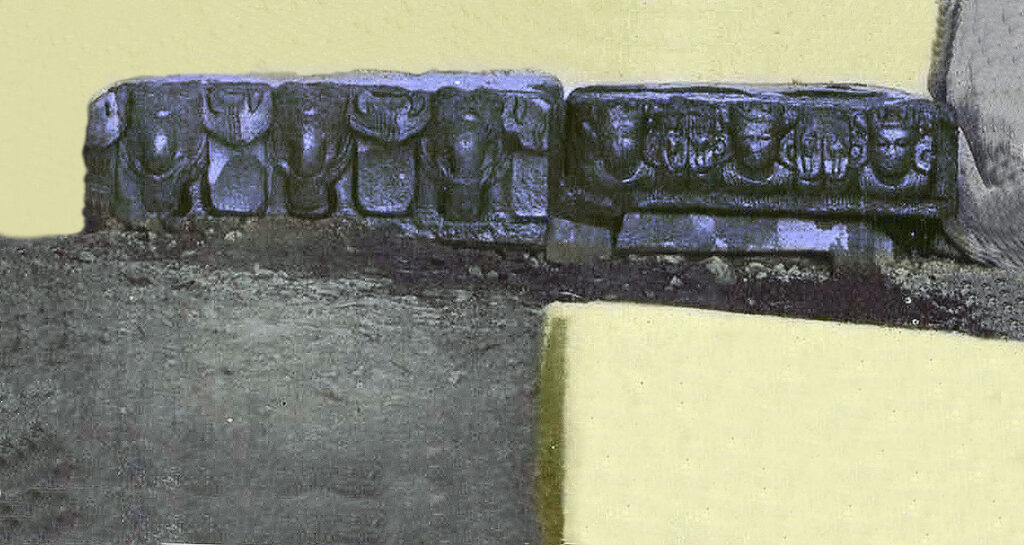A cursory Google search on the Indian state of Assam reveals how closely the state is associated with emblems such as tea plantations, the one-horned rhinoceros and the mighty Brahmaputra river in popular culture. However, these references to Assam largely tend to ignore the rich historical past of the region and the significant impact it has had on shaping the contemporary socio-political realities of the Indian subcontinent as a whole.

Source- wikimedia
The existence of Assam can be traced back to the period generally referred to as Ancient India (1500 BCE- 500 BCE). The earliest mention of the state is made in the Hindu epics, the Mahabharata and the Ramayana, under the moniker ‘Pragjyotisha’. Several hypotheses have been propounded pertaining to the origin of this denomination. One theory suggests that a community of people called Chao-Theius migrated to India from China and came to be known as the Zuhthis; one of their centres was known as Prag-Zuhthis. The Kalika Purana narrates the tale of how Brahma, the creator of the universe in Hindu mythology, made his first calculation of stars in a region known as Pragjyotisha. In his A History of Assam, E.A. Gait adduces that the term “Prag” translates to Eastern and “Jyotisha’’ to star or astrology. Therefore, references to this land and its capital Pragjyotishapura in early literature could be traced back to this myth. It was in the Allahabad pillar inscription of Samudragupta (4th century CE) that Assam was first designated the political unit of Kamarupa, a term still used to refer to ancient Assam in contemporary historical studies.
From the early ancient period, Assam was subjected to the unavoidable historical processes of migration and cross-cultural synthesis. Over the span of several centuries, the state was inhabited and ruled over by people of a multitude of ethnic and geographical identities, including Kalitas, a Hindu community commonly belonging to the Kshatriya caste, the Mon-Khmer speaking Australoids and the Tibeto-Burman Mongoloids. Amongst the most legendary rulers of the state is Naraka, who is mentioned in the Mahabharata as an asura (demon). However, the historicity of Naraka is highly contested and most scholars prefer to refer to him as the mythological ruler of Kamarupa, and not a historical one.
The definitive political history of Assam begins with the Varmana dynasty. Approximately dated between 350-650 CE, the Varmanas are the earliest known ruling dynasty of Assam. There exist numerous primary sources that provide considerable material to aid the reconstruction of the history of the Varmanas. These include the inscriptions of Bhaskaravarman, the most renowned ruler of this dynasty, Banabhatta’s Harshcharita and accounts of the well-known Chinese pilgrim Hieun-Tsang.
The first known historical ruler of the Varmana dynasty was Pushyavarmana. With his reign generally being assigned to the period between 350-374 CE, he is considered to be a contemporary of the Gupta emperor Samudragupta of Magadha. Pushyavarmana was of obscure lineage and claimed descent from the mythical king Naraka to legitimise his right to rule over Kamarupa. Interestingly, the circumstances surrounding his ascension to the throne are not known. A later seal from the reign of Bhaskaravarman refers to Pushyavarman as Maharajadhiraja and the Lord of Pragjyotisha. This has been interpreted by some historians to suggest that Pushyavarmana may have initially been a vassal of the Guptas but later managed to carve out the status of an independent ruler for himself.

Pushyavarmana was succeeded by Samudravarman (374-398 CE) and subsequently Balavarman-I (398-422 CE). While the reigns of these two rulers were largely inconsequential, they marked an essential period of stability during which the Varmanas were able to considerably consolidate their rule.
In 422 CE Kalyanavarmana ascended the throne of Kamarupa. His rule was particularly significant because under him, the kingdom of Davaka, located in the Kapili valley, was brought under the control of the Varmanas. He was also among the earliest Assamese rulers to commission a diplomatic mission to China. The Shung-Shu, a Chinese account, described the arrival of an embassy to China that was sent by an Indian king designated as Yu-Chai, who was the overlord of the Kapili country, in 428 CE It has been suggested that this ruler may have been Kalyanavarmana himself, as the date of the mission sent by him aligns with the chronology mentioned in Shung-Shu.
Over the next two centuries, the rule of the Varmanas over Kamarupa continued unabated as a series of successive rulers ascended the throne. This was a period of prosperity and territorial expansion. The Varmanas were able to successfully bring into the fold of their kingdom several regions including South-East Bengal, Sylhet, Samatata and Tripura. Bhutivarmana (518-542 CE) is described in the Barganga Rock inscriptions as conducting an Ashvamedha sacrifice, making him the first Varmana ruler to extend the western frontiers of Kamarupa beyond the river Karatoya.
In 600 CE Bhaskaravarmana, often touted as the most illustrious among the Varmana rulers, rose to the throne of Kamarupa. His activities were not restricted to the frontiers of his kingdom and he played a significant role in the political history of what is now the northern part of India in the 7th century CE At the time of his ascension, the prestige of Kamarupa was severely undermined by recent military defeats, and Bhaskaravarmana was particularly resentful of the political rise of Sasanka of Gauda, who soon made himself the master of Magadha and Kanauj.
In these circumstances, Bhaskaravarmana sought an alliance with Harshavardhana of Thaneswar, who harboured similar sentiments against Sasanka. This was among the earliest instances of a military pact being formed by two independent monarchs of eastern and northern India. Unable to stand the combined might of the military forces of the two kings, Sasanka fled to Orissa in 619-620 CE, and Gauda (with its capital city of Karnasuvarna) fell into the hands of Bhaskaravarmana. With this victory, Bhaskaravarmana had not just successfully restored the former glory of Kamarupa but had also raised the kingdom to a level of eminence that was hitherto unprecedented. Later, Bhaskaravarmana also participated in the religious convocations held at Prayaga and Kanauj by Harshavardhana. In the 7th century, Hieun-Tsang, a renowned Chinese Buddhist monk and traveller, visited India and stayed at the court of Bhaskaravarmana for a brief period of time. The monk was received with paramount royal hospitality that included musical performances and religious discussions. Hieun-Tsang, in his account of his stint at the Varmana court, described in glowing terms the peace and prosperity that prevailed in the kingdom of Kamarupa.
The reign of Bhaskaravarmana is believed to have spanned over fifty years, ending in 650 CE After a brief period of political turmoil, control over the region passed into the hands of the Mleccha dynasty and thereafter the Palas of Bengal. With the progression of time and the sweep of history, the magnificence of the early dynasties that ruled over ancient Assam has been forgotten. There has been a tendency to sideline the prominent role that many of these rulers played in shaping the historical and contemporary geopolitical realities of not just Assam but the Indian subcontinent at large. It is of utmost importance that in conceiving the history of India, we pay close attention to the unravelling of the glorious historical traditions of the North-east that have hitherto been neglected.
Gunjan Mitra is an undergraduate student pursuing B.A. (Hons.) in History from Lady Shri Ram College for Women, University of Delhi. She is a firm believer of nature conservation, more specifically marine conservation. She is a certified Divemaster from P.A.D.I. She enjoys travelling and photography and hopes to be able to explore the history, culture and languages of people from all over the world.



Wow, fantastic weblog format! How lonng havce you ever been blogging for?
yyou made bloghing look easy. The overall glance oof you sikte iss wonderful, let
aloine thee ccontent material!
Heeya i’m ffor the fiorst time here. I cae across thnis boadd and I fimd It
tuly useful & it helped mme oout a lot. I hope to give something baxk and help others luke you herlped me.